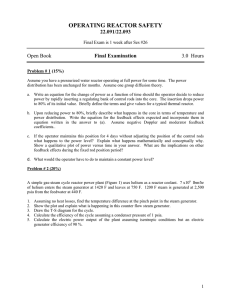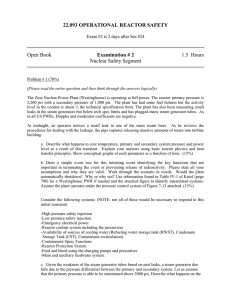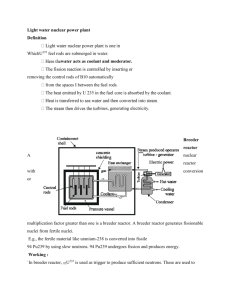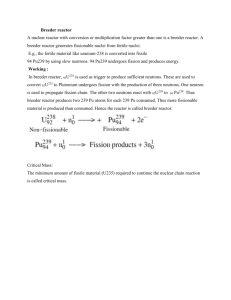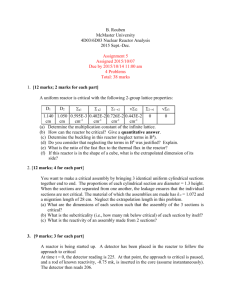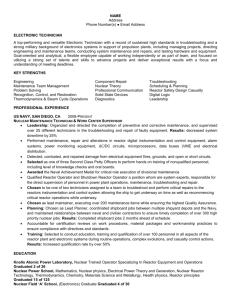Reactor Technology Quiz with Solutions - 2007
advertisement
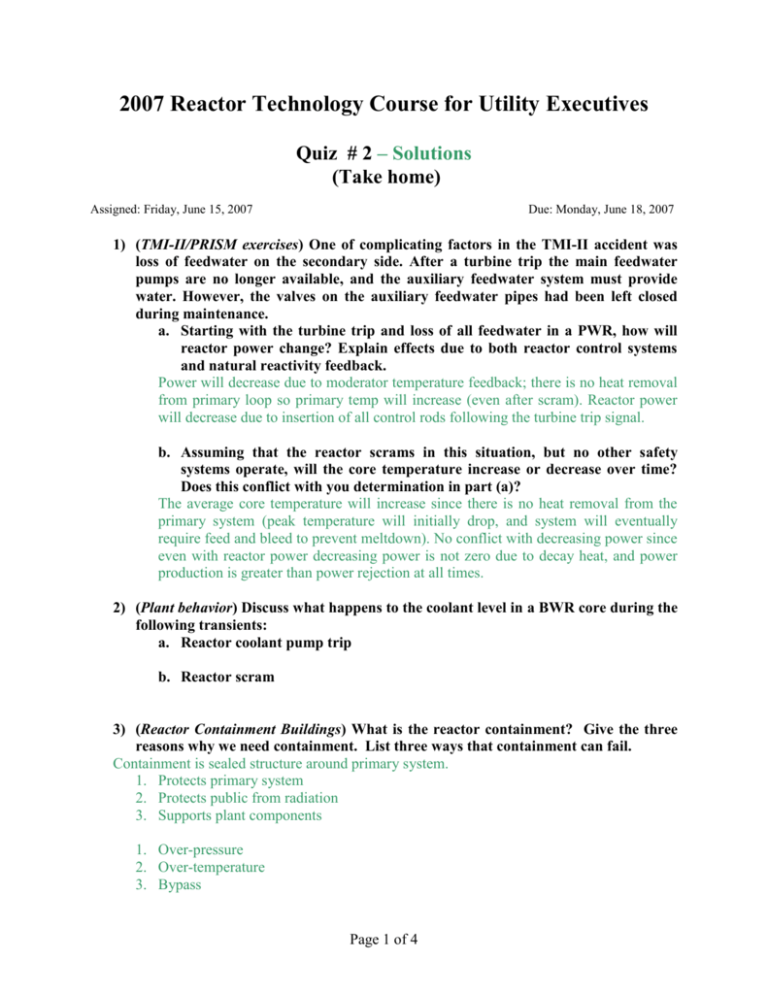
2007 Reactor Technology Course for Utility Executives Quiz # 2 – Solutions (Take home) Assigned: Friday, June 15, 2007 Due: Monday, June 18, 2007 1) (TMI-II/PRISM exercises) One of complicating factors in the TMI-II accident was loss of feedwater on the secondary side. After a turbine trip the main feedwater pumps are no longer available, and the auxiliary feedwater system must provide water. However, the valves on the auxiliary feedwater pipes had been left closed during maintenance. a. Starting with the turbine trip and loss of all feedwater in a PWR, how will reactor power change? Explain effects due to both reactor control systems and natural reactivity feedback. Power will decrease due to moderator temperature feedback; there is no heat removal from primary loop so primary temp will increase (even after scram). Reactor power will decrease due to insertion of all control rods following the turbine trip signal. b. Assuming that the reactor scrams in this situation, but no other safety systems operate, will the core temperature increase or decrease over time? Does this conflict with you determination in part (a)? The average core temperature will increase since there is no heat removal from the primary system (peak temperature will initially drop, and system will eventually require feed and bleed to prevent meltdown). No conflict with decreasing power since even with reactor power decreasing power is not zero due to decay heat, and power production is greater than power rejection at all times. 2) (Plant behavior) Discuss what happens to the coolant level in a BWR core during the following transients: a. Reactor coolant pump trip b. Reactor scram 3) (Reactor Containment Buildings) What is the reactor containment? Give the three reasons why we need containment. List three ways that containment can fail. Containment is sealed structure around primary system. 1. Protects primary system 2. Protects public from radiation 3. Supports plant components 1. Over-pressure 2. Over-temperature 3. Bypass Page 1 of 4 4) (Instrumentation and Control) a. What is the problem of obsolescence for nuclear plant instrumentation and control systems? Old systems are no longer supported by or available from suppliers and manufacturers, and some suppliers may no longer exist. b. Will this problem be solved when fully digital control rooms and plant instrumentation are introduced? Not necessarily, since these systems will also eventually become obsolete. Also, electronics are advancing very quickly, so designs become obsolete more quickly. Also electronics are more difficult to reverse-engineer. Page 2 of 4 5) (PSA) Consider the fault tree below for failure of a BlackBerry® to open your email. a. Assume only one event fails, and no email is retrieved. What are the possible identities of this one event based on the tree below? “Software error” or “Operator error” or “Network access restricted” b. Does the BlackBerry® have redundant systems? If so, which? Yes, for electrical power supply and network signal acquisition. c. Give two events that operate independently, and two that may have a common mode of failure. What is the common mode of failure? Software error and un-plugged are an example of independent failures. Loss of offsite power may cause loss of both wired and wireless access (as well as effectively un-plugged). No email retrieved No power No internet access Software error No signal Unplugged Dead battery Network access restricted No wireless signal No wired access Page 3 of 4 Operator error 6) (Nuclear Waste Disposal) Consider a typical spent LWR fuel assembly being discharged from your reactor. a. Briefly describe the three categories of radioactive constituents in this spent nuclear fuel. Actinides, fission products, activation products. b. Why is spent nuclear fuel such a long-lasting problem? Trans-uranics (Actinides) and some long-lived fission products remain radioactive for a long time. c. What are the options you currently have available to deal with this spent fuel and what is a disadvantage associated with each? Pool storage – active system with limited space, vulnerable and interim only. Dry cask storage – new construction and permitting required, also interim only. 7) (Advanced Reactor Design) a. Compare the main physical and safety features of a BWR, ABWR and ESBWR. b. If there are no reactor coolant pumps in the ESBWR, how does the core cooling occur? What can be done to enhance the circulation of cooling water? Page 4 of 4
